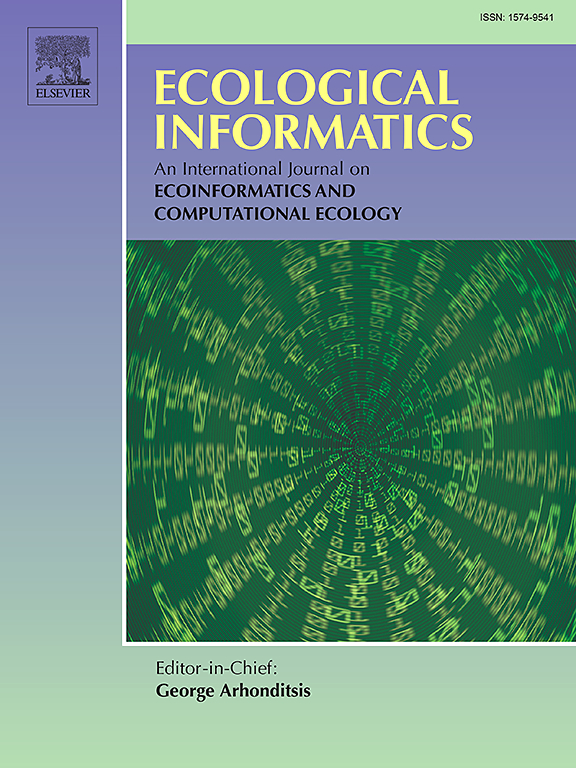3000公里干旱梯度下植物C:N:P化学计量特征及其驱动因素
IF 7.3
2区 环境科学与生态学
Q1 ECOLOGY
引用次数: 0
摘要
叶片元素化学计量学对了解陆地生态系统的营养动态和碳(C)循环至关重要。然而,叶片C、氮和磷含量的生物地理格局及其沿干旱梯度的化学计量关系仍然知之甚少,特别是关于它们的驱动因素。本研究在中国3000公里的干旱梯度范围内,包括36个代表森林、草地和沙漠生态系统的采样点,研究了叶片C:N的化学计量特征。我们进一步研究了叶片生化性状与环境驱动因子的关系。结果表明,叶片中碳、氮、磷的平均含量分别为588.29±6.9、19.11±0.3和1.33±0.03 g kg−1。C:N、C:P和N:P比值分别为32.43±0.64、480.65±11.36和15.71±0.4。叶片C:N:P化学计量学表现出普遍的非线性模式,干旱指数(AI)的阈值约为0.7。在此阈值(AI <0.7)以下,叶片碳磷比和氮磷比随AI的增加而降低,氮限制更加明显。相反,这些比值高于该阈值(AI >0.7),表明磷有效性日益制约植物生长。此外,干旱地区的植物(AI <0.7)表现出很强的化学计量稳态,表明对环境波动有有效的生理适应。这种自我平衡能力在潮湿地区大大减弱(AI >0.7),在那里植物表现出更大的化学计量可塑性。这些发现促进了我们对叶片养分化学计量的空间格局的理解,并为全球气候变化情景下生态系统养分循环的建模提供了重要见解。本文章由计算机程序翻译,如有差异,请以英文原文为准。

Patterns and drivers of plant C:N:P stoichiometry across a 3000 km aridity gradient
Leaf element stoichiometry is crucial for understanding nutrient dynamics and carbon (C) cycling in terrestrial ecosystems. However, the biogeographical patterns of leaf C, nitrogen (N), and phosphorus (P) content and their stoichiometric relationships along aridity gradients remain poorly understood, particularly regarding their driving factors. This study examined leaf C:N stoichiometry across a 3000 km aridity gradient in China, encompassing 36 sampling sites representing forest, grassland, and desert ecosystems. We further investigated the relationships between leaf biochemical traits and environmental drivers. Results revealed that the mean leaf contents of C, N, and P at 588.29 ± 6.9, 19.11 ± 0.3, and 1.33 ± 0.03 g kg−1, respectively. The C:N, C:P, and N:P ratios were obtained as 32.43 ± 0.64, 480.65 ± 11.36, and 15.71 ± 0.4, respectively. The leaf C:N:P stoichiometry exhibited a pervasive nonlinear pattern, and a threshold of approximately 0.7 on an aridity index (AI). Below this threshold (AI <0.7), the leaf C:P and N:P ratios decreased as AI increased, and N limitation became more evident. Conversely, these ratios increased above this threshold (AI >0.7), indicating that P availability increasingly constrained plant growth. Furthermore, plants in arid regions (AI <0.7) demonstrated strong stoichiometric homeostasis, suggesting effective physiological adaptation to environmental fluctuations. This homeostatic capacity substantially weakened in humid regions (AI >0.7), where plants showed greater stoichiometric plasticity. These findings advance our understanding of spatial patterns in leaf nutrient stoichiometry and provide critical insights for modeling ecosystem nutrient cycling under global climate change scenarios.
求助全文
通过发布文献求助,成功后即可免费获取论文全文。
去求助
来源期刊

Ecological Informatics
环境科学-生态学
CiteScore
8.30
自引率
11.80%
发文量
346
审稿时长
46 days
期刊介绍:
The journal Ecological Informatics is devoted to the publication of high quality, peer-reviewed articles on all aspects of computational ecology, data science and biogeography. The scope of the journal takes into account the data-intensive nature of ecology, the growing capacity of information technology to access, harness and leverage complex data as well as the critical need for informing sustainable management in view of global environmental and climate change.
The nature of the journal is interdisciplinary at the crossover between ecology and informatics. It focuses on novel concepts and techniques for image- and genome-based monitoring and interpretation, sensor- and multimedia-based data acquisition, internet-based data archiving and sharing, data assimilation, modelling and prediction of ecological data.
 求助内容:
求助内容: 应助结果提醒方式:
应助结果提醒方式:


